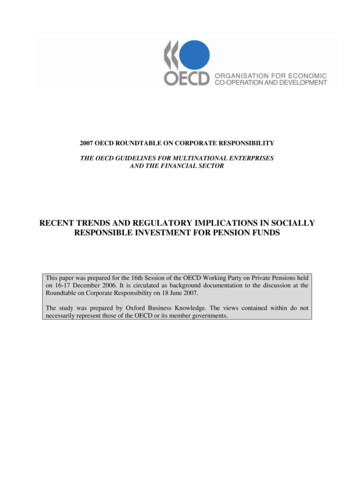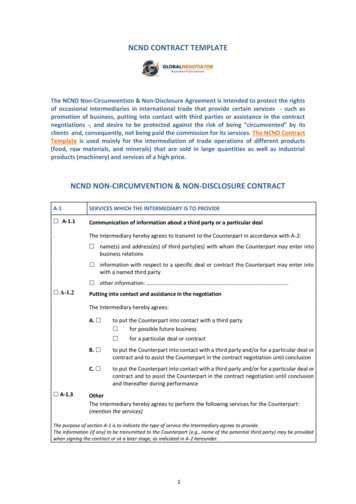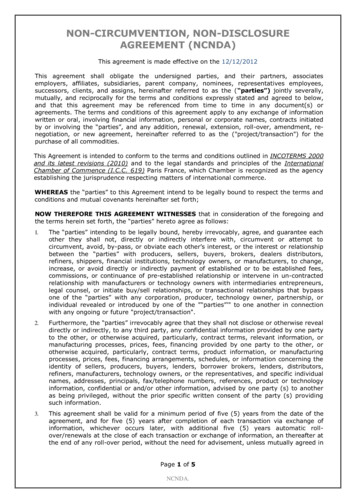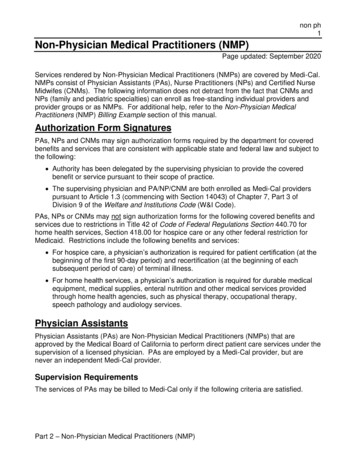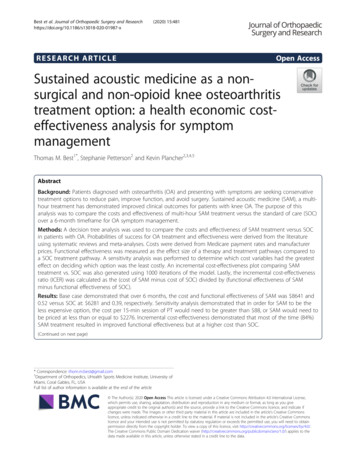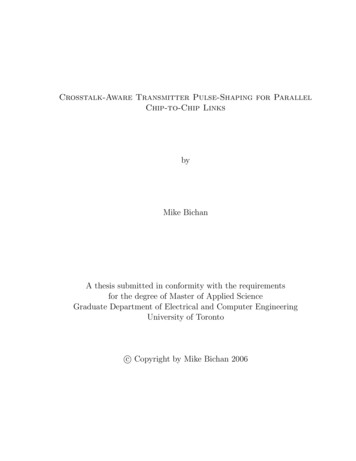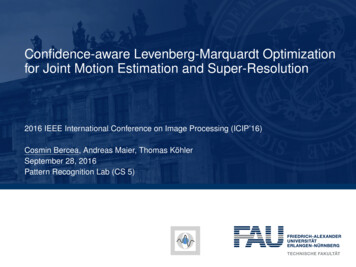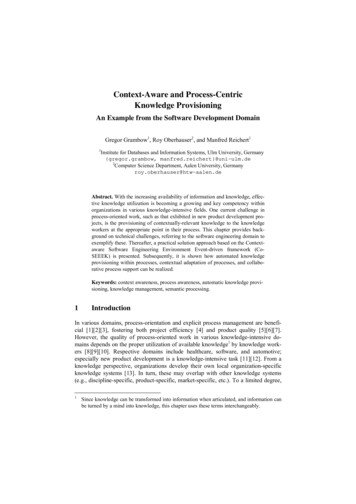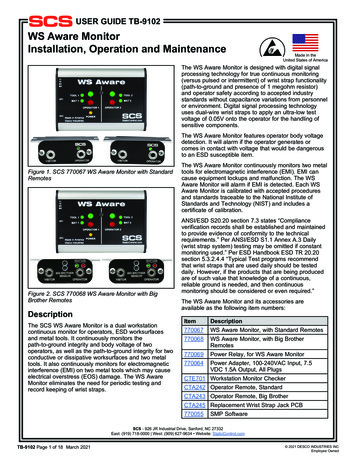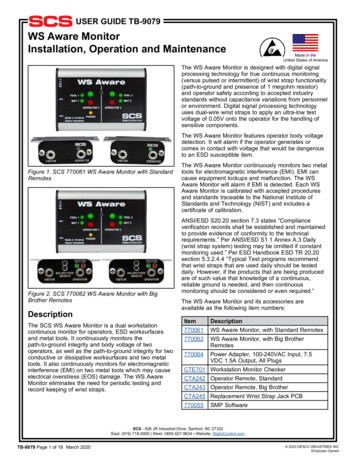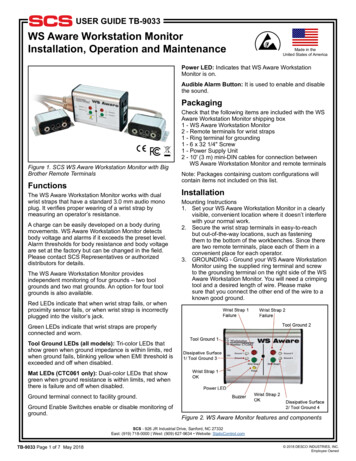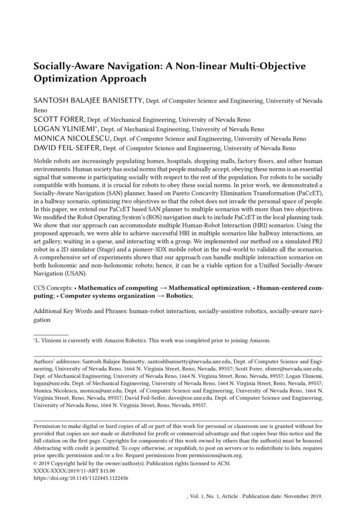
Transcription
Socially-Aware Navigation: A Non-linear Multi-ObjectiveOptimization ApproachSANTOSH BALAJEE BANISETTY, Dept. of Computer Science and Engineering, University of NevadaRenoSCOTT FORER, Dept. of Mechanical Engineering, University of Nevada RenoLOGAN YLINIEMI , Dept. of Mechanical Engineering, University of Nevada RenoMONICA NICOLESCU, Dept. of Computer Science and Engineering, University of Nevada RenoDAVID FEIL-SEIFER, Dept. of Computer Science and Engineering, University of Nevada RenoMobile robots are increasingly populating homes, hospitals, shopping malls, factory floors, and other humanenvironments. Human society has social norms that people mutually accept, obeying these norms is an essentialsignal that someone is participating socially with respect to the rest of the population. For robots to be sociallycompatible with humans, it is crucial for robots to obey these social norms. In prior work, we demonstrated aSocially-Aware Navigation (SAN) planner, based on Pareto Concavity Elimination Transformation (PaCcET),in a hallway scenario, optimizing two objectives so that the robot does not invade the personal space of people.In this paper, we extend our PaCcET based SAN planner to multiple scenarios with more than two objectives.We modified the Robot Operating System’s (ROS) navigation stack to include PaCcET in the local planning task.We show that our approach can accommodate multiple Human-Robot Interaction (HRI) scenarios. Using theproposed approach, we were able to achieve successful HRI in multiple scenarios like hallway interactions, anart gallery, waiting in a queue, and interacting with a group. We implemented our method on a simulated PR2robot in a 2D simulator (Stage) and a pioneer-3DX mobile robot in the real-world to validate all the scenarios.A comprehensive set of experiments shows that our approach can handle multiple interaction scenarios onboth holonomic and non-holonomic robots; hence, it can be a viable option for a Unified Socially-AwareNavigation (USAN).CCS Concepts: Mathematics of computing Mathematical optimization; Human-centered computing; Computer systems organization Robotics;Additional Key Words and Phrases: human-robot interaction, socially-assistive robotics, socially-aware navigation L.Yliniemi is currently with Amazon Robotics. This work was completed prior to joining Amazon.Authors’ addresses: Santosh Balajee Banisetty, santoshbanisetty@nevada.unr.edu, Dept. of Computer Science and Engineering, University of Nevada Reno, 1664 N. Virginia Street, Reno, Nevada, 89557; Scott Forer, sforer@nevada.unr.edu,Dept. of Mechanical Engineering, University of Nevada Reno, 1664 N. Virginia Street, Reno, Nevada, 89557; Logan Yliniemi,logan@unr.edu, Dept. of Mechanical Engineering, University of Nevada Reno, 1664 N. Virginia Street, Reno, Nevada, 89557;Monica Nicolescu, monica@unr.edu, Dept. of Computer Science and Engineering, University of Nevada Reno, 1664 N.Virginia Street, Reno, Nevada, 89557; David Feil-Seifer, dave@cse.unr.edu, Dept. of Computer Science and Engineering,University of Nevada Reno, 1664 N. Virginia Street, Reno, Nevada, 89557.Permission to make digital or hard copies of all or part of this work for personal or classroom use is granted without feeprovided that copies are not made or distributed for profit or commercial advantage and that copies bear this notice and thefull citation on the first page. Copyrights for components of this work owned by others than the author(s) must be honored.Abstracting with credit is permitted. To copy otherwise, or republish, to post on servers or to redistribute to lists, requiresprior specific permission and/or a fee. Request permissions from permissions@acm.org. 2019 Copyright held by the owner/author(s). Publication rights licensed to ACM.XXXX-XXXX/2019/11-ART 15.00https://doi.org/10.1145/1122445.1122456, Vol. 1, No. 1, Article . Publication date: November 2019.
2Banisetty, et al.ACM Reference Format:Santosh Balajee Banisetty, Scott Forer, Logan Yliniemi, Monica Nicolescu, and David Feil-Seifer. 2019. SociallyAware Navigation: A Non-linear Multi-Objective Optimization Approach. 1, 1 (November 2019), 25 ODUCTIONSocial norms such as driving on the right or left side of the road (depending on the country onelives in), turn-taking rules at four-way stops and roundabouts, holding doors for people behind us,and maintaining an appropriate distance when interacting with another person (actual distancedepending on the type of interaction) are crucial in our day-to-day interactions. People use theseactions as signals that they are participants in the social order. Violating these principles is jarringat best (i.e., a person becoming confused at another person’s behavior), and can provoke hostilityat worst (i.e., getting upset at someone for cutting in line).As socially assistive robots (SAR) [17] are expected to play an essential role in a human-robotcollaborative environment, these robots taking roles while remaining unconstrained to such socialnorms is a growing concern in the robotics community. In the last decade, social and personalrobots have attained immense interest among researchers and entrepreneurs alike; the result is anincrease in the efforts both in industry and academia to develop applications and businesses in thepersonal robotics space. Smart Luggage [15], showcased at 2018’s consumer electronics show (CES),a robotic suitcase that will follow the owner during travel, demonstrates the commercial viability ofinterpersonal navigation. Some companies and start-ups develop robotic assistants for airports andshopping malls to assist people with directions and shopping experience. Robot domains, especiallySAR, benefit from navigation as such movement extends the reachable service area of the robot.However, navigation, if not appropriately performed, can cause an adverse social reaction [38]. Inan ethnographic study where nurses in hospital settings interacted with an autonomous servicerobot, one of the participants quoted the following statement:“Well; it almost ran me over. I wasn’t scared. I was just mad. I’ve already been clipped by it.It does hurt.”Robots currently deployed in human environments have prompted adverse reactions from peopleencountering them [10]. Some people are not willing to interact with these robots, and some ofthem even kicked them, demonstrating a very hostile attitude towards service robots. Incidents suchas these pose both challenges and opportunities for the human-robot interaction (HRI) researchers;as a result, recent years have seen a tremendous growth of publication in areas related to sociallyaware navigation such as human detection and tracking, social planner incorporating social norms,human-robot interaction studies to understand the problem from a human’s perspective.As seen from the examples so far [25, 38], SAR systems without social-awareness can causeproblems in human environments. Following the social norms posed by human society may helprobots be more accepted in homes, hospitals, and workplaces. Robots, by means of their navigationbehavior, should not treat humans as dynamic objects, as shown in our results in Figure 1. Thefigure illustrates a comparison between a traditional planner (green trajectory) that optimizesperformance (time, distance, etc.) and a socially-aware planner (blue trajectory), which optimizesfor social norms along with performance metrics. The traditional planner treats both human andan object the same way (not maintaining enough distance around human and object), however,that is not acceptable. It is acceptable to get close to an object, but a similar behavior around aperson is not acceptable., Vol. 1, No. 1, Article . Publication date: November 2019.
Socially-Aware Navigation: A Non-linear Multi-Objective Optimization Approach3Fig. 1. The PaCcET local planner (blue, solid) compared with the traditional ROS local planner (green, dotted),which does not account for social norms. The traditional planner generated a trajectory that is close toboth human and the object (black box), treating them alike. Our approach, the PaCcET-based SAN planner,generated a trajectory that diverged around the human, thereby respecting the personal space of the human.Socially-Aware Navigation planners, including our method, considers the theory of proxemicsand other social norms such that the robot does not invade the space around the human. Proxemics[23] codifies this notion of personal space; researchers interested in socially-aware navigation(SAN) are investigating methods to integrate the rules of proxemics into robot navigation behavior.Our approach to SAN using PaCcET addresses the following limitations of the existing approaches:(1) Many current approaches depend on exocentric sensing, limiting the robot’s services to aparticular environment [16].(2) Approaches may require a large amount of training data [1, 24, 28, 30, 40].(3) The environment/scenario is a singleton, i.e., Only a hallway, a room, etc., is considered, orconsiders only an approach behavior or a passing behavior [16].(4) Planners are optimized for single or few objectives with linear combination or weightedsum [18, 19].This paper builds on our previous work from [21] and provides a comprehensive evaluation ofour SAN planner in multiple scenarios in both simulations and the real-world. We extend our priorwork by implementing our proposed method on a real robot with objectives like inter-personaldistance, adherence to a social goal, activity space, and group proxemics as well as providing a morediverse set of simulated environments and real-world scenarios for evaluation. The remainder ofthis paper is structured as follows. We implemented our proposed SAN method on both holonomicand non-holonomic platforms. In the next section, we review related works. In Section 3, we presentour approach to SAN using PaCcET. In Section 4, we apply our method to various scenarios insimulation and on a pioneer-3DX platform to validate the proposed approach. Finally, in Section 5,we discuss our present and on-going work.22.1RELATED WORKSocially-Aware NavigationWhen localization and navigation were relatively new in the field of robotics, tour guide robotsRhino and Minerva [8, 9, 49] successfully navigated and gave museum tours for visitors. Theserobots were some of the pioneering works in the field of robot navigation, which performed variousnavigation functions like mapping, localization, collision avoidance, and path planning. These robots, Vol. 1, No. 1, Article . Publication date: November 2019.
4Banisetty, et al.also exhibited primitive navigation behaviors around people in a dynamic human environment.Robust long-term navigation in the indoor environment was demonstrated by Marder et al. [34]when a PR2, a mobile manipulation robot completed a 26.2 mile run in an office environment. Thisstate-of-the-art navigation technique (traditional planner) can generate a collision-free path andmaneuver a robot on that path to get to a goal. However, these algorithms are not sophisticatedenough to deal with social interactions that occur while navigating in highly dynamic humanenvironments.There is a rapidly growing HRI community that is addressing social navigation planners. Mostof the SAN research can be broadly classified (based on areas concerning social navigation) intoPlanning, Perception, and Behavior Selection. Most of the work is concentrated in the planningarea (in turn classified into local planning and global planning). The solutions to SAN associatedproblems range from simple cost functions to more advanced deep neural networks; we presentsome of them here.Social Force Model (SFM) [26] is one of the popular approaches to SAN, which mimics humannavigation behavior. Building upon prior work, Ferrer et al. programmed a robot to obey the socialforces during navigation activities [18, 19]. The method also extends SFM to allow a robot toaccompany a human while providing a method for learning the model parameters. Kivrak et al. [29]also adopted SFM to be used as a local planner to generate a socially aware trajectory in a hallwayscenario. Silva et al. [46] took a shared effort approach to solve the human-robot collision avoidanceproblem using Reinforcement Learning. Simulated results show that the approach enabled theagents (human and robot) to avoid a collision mutually. Our proposed approach is validated not ina single context but multiple contexts like hallway interactions, joining a group of people, waitingin a line, and an art gallery interaction.Dondrup et al. [14] proposed a combination of well-known sample-based planning and velocitycostmaps to achieve socially-aware navigation. The authors used a Bayesian temporal model torepresent the navigation intent of robot and human based on Qualitative Trajectory Calculus andused these descriptors as constraints for trajectory generation. Alonso et al. [2] presented a ϵcooperative collision avoidance method in dynamic environments among interactive agents (robotsor humans). The method relies on reciprocal velocity obstacles, given a global path, to computea collision-free local path for a short duration. Turnwald et al. [50] presented a game-theoreticapproach to SAN utilizing concepts from non-cooperative games and Nash equilibrium. This gametheory-based SAN planner was evaluated against established planners such as reciprocal velocityobstacles or social forces, a variation of the Turing test was administered which determines whetherparticipants can differentiate between human motions and artificially generated motions. Arooret al. [3] formulated a Bayesian approach to develop an online global crowd model using a laserscanner. The model uses two new algorithms, CUSUM-A (to track the spatiotemporal changes)and Risk-A (to adjust for navigation cost due to interactions with humans), that rely on localobservation to continuously update the crowd model. Unlike other model-based approaches, ourmethod does not require any training data to perform socially-aware navigation.Okal et al. [40] presented a Bayesian Inverse Reinforcement Learning (BIRL) based approach toachieving socially normative robot navigation using expert demonstrations. The method extendsBIRL to include a flexible graph-based representation to capture the relevant task structure thatrelies on collections of sampled trajectories. Kim et al. [28] presented an Inverse ReinforcementLearning (IRL) based framework for socially adaptive path planning to generate human-like trajectories in dynamic human environments. The framework consists of three modules: a featureextractor, a learning module, and a path planning module. Kretzschmar et al. [30] proposed amethod, to learn policies from demonstrations, to learn the model parameters of cooperative humannavigation behavior that match the observed behavior concerning user-defined features. They, Vol. 1, No. 1, Article . Publication date: November 2019.
Socially-Aware Navigation: A Non-linear Multi-Objective Optimization Approach5used Hamiltonian Markov chain Monte Carlo sampling to compute the feature expectations. Toadequately explore the space of trajectories, the method relied on the Voronoi graph of the environment from start to target position of the robot. Our proposed method performs Pareto concavityelimination, thereby considers non-linear solution space.Human motion prediction is of vital importance in SAN as it allows the robot to plan andexecute its motion behaviors according to the predicted human motion. In contrast to traditionalhuman trajectory prediction approaches that use hand-crafted functions (social forces), Alahi etal. [1] proposed an LSTM (Long Short-Term Memory) model which can observe general humanmotion and predict their future trajectories. Hamandi et al. [24] developed a novel approach usingdeep learning (LSTM) called DeepMoTIon, trained over public pedestrian surveillance data topredict human velocities. The DeepMoTIon method used a trained model to achieve human-awarenavigation, where the robots imitate humans to navigate in crowded environments safely.Although SAN research is dominated by planning related advancements, for a long-term HRI inhuman environments, we need to understand how cooperative human navigation works. Psychologists and roboticists are looking into social cues, and their effects on HRI to better understand thesocially-aware navigation problem. Suvei et al. [47] investigated the problem of “how a robot canget closer to people that it wants to interact with?" In a 2x2 between-subject study, the authorsinvestigated the effect of social gaze cue on the personal space invasion using a human-sizedmobile robot. The results from a 2 x 2 between-subjects experiment, with/without personal spaceinvasion, and with/without a social gaze cue, indicate that social gaze did play a role in participants’perceived safety of the robot. In another study, Tan et al. showed that bystanders and observers ofHRI felt safer around the robot than the actual interaction partner even though they both were invery close proximity to the robot [48]. The authors justify the design of the robot by collecting theresponses of invited users evaluating the properties and appearance of the robot while interactingwith it. Rajamohan et al. [41], studied the role of robot height in HRI related to preferred interactiondistance. Subjective data showed that participants regarded robots more favorably following theirparticipation in the study. Moreover, participants rated the NAO most positively and the PR2 (Tall,with a fully expanded telescoping spine) most negatively.2.2Multi-Objective OptimizationIt is easy to think of a task as a single objective function, where there is a goal or cost functionthat we are trying to either minimize or maximize. Ideally, this would always give the optimalsolution for a task; however, this is not always the case. More often than not, multiple variablescontribute to a cost function. An example of this is from basic economics, where there exists amarket for a widget. As the supply of this widget goes up, the demand decreases and vice-versa.This phenomenon would be known as a supply and demand curve where one objective is thesupply, and the other is the demand. In this case, the seller would want to find the optimal amountof supply, such that demand provides the optimal amount of profit. If graphed, this supply anddemand curve, as shown in Figure 2, the points on the line would be Pareto optimal points; nopoint dominates any other. In this case, the seller is trying to maximize both objectives; therefore,the hollow circles are the dominated points as there exist solid circle points that are better in bothobjectives. Typically, multiple Pareto optimal points are forming a set, which is the solution typethat many multi-objective algorithms use [12].Multi-objective optimization has already started to play a role in real-world applications [35].Some examples of real-world multi-objective scenarios are high speed civilian aircraft transportation [36], urban planning [4], and for designing trusses [11]. The trajectory planner used in thispaper builds off of a pre-existing one that utilizes a multi-objective approach along with linearcombination [34]., Vol. 1, No. 1, Article . Publication date: November 2019.
6Banisetty, et al.Fig. 2. Multi-Objective solution space - The Pareto front contains the non-dominated solutions based on thethe two objectives.2.2.1 PaCcET. In some cases, optimizing a single objective does not yield the desired performance,and therefore multiple objectives need to be considered when evaluating a policy’s fitness. Astandard method is to multiply a preset scalar value to each objective’s fitness score and then addthem all together. In some domains, this can lead to an optimal set of policies; however, in somecomplicated domains, this method will yield sub-op
Socially-Aware Navigation: A Non-linear Multi-Objective Optimization Approach SANTOSH BALAJEE BANISETTY, Dept. of Computer Science and Engineering, University of Nevada Reno SCOTT FORER, Dept. of Mechanical Engineering, University of Nevada Reno LOGAN YLINIEMI , Dept. of Mechanical Engineering, University of Nevada Reno MONICA NICOLESCU, De
